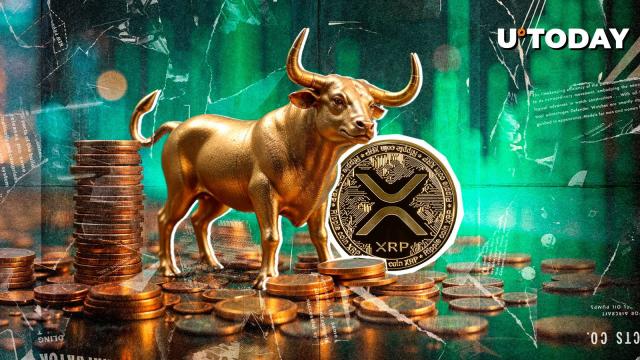Driven by the release of signals of easing trade tensions between China and the United States and the temporary easing of the Federal Reserve's policy uncertainty, Bitcoin broke through $94,000 in the short term, once again stimulating the market's enthusiasm for "digital gold."
Related reading: " Bitcoin surges 7%, is the 'digital gold' narrative back? "

This round of rise is not just a short-term reaction of the market to the warming of Sino-US trade relations, but more like a risk repricing under the superposition of multiple macro signals. In this storm of policy games and risk aversion, Bitcoin is once again regarded as a "safe haven" for capital, and its price surge may be the market's early response to future inflation, US dollar credit and changes in the global geopolitical landscape.
However, is this round of price surge the starting point of a structural reversal or a phased rebound driven by policy games? Market opinions diverge significantly.
On the one hand, the funding and policy sides have released positive signals of "risk repricing". The Trump administration's softening attitude towards tariff policy, its temporary "letting go" of Powell, and Wall Street's high-profile participation in Bitcoin funds are all seen as a reflection of the rise and fall of the roles of traditional safe-haven assets and digital assets. Institutions such as QCP and Matrixport regard the rise of Bitcoin as an active pricing adjustment under the change of macro trends, and point out that funds are flowing from traditional assets such as gold into the crypto market.
On the other hand, some technical analysts and senior traders remain cautious, believing that the current rise has not yet completed the structural confirmation required for a trend reversal. From wave patterns, RSI indicators to liquidity-intensive intervals, long and short signals are intertwined and complex, and the current market is closer to a strong rebound rather than a trend reversal. Technical judgments unanimously emphasize that only when Bitcoin effectively breaks above $95,000 and stabilizes can a new round of bullish trend begin.
Institutional Analysis
QCP Capital released its daily market analysis, saying that Cantor, SoftBank, Tether and Bitfinex have jointly launched a bold Bitcoin acquisition fund called 21 Capital (tentative name). This move comes at a time when the US policy stance has undergone a decisive change. The Trump administration tends to support the "digital gold" narrative, which has brought a boost to the cryptocurrency market.
Bitcoin managed to break through the psychological barrier of $90,000. Meanwhile, gold slipped 6%, highlighting the recovery of investor interest in risky assets and clearly showing capital flows into digital assets.
Institutional investors are no longer just testing the waters of cryptocurrencies, but are fully invested. As Strategy's strategy gradually fades, 21 Capital is expected to become the new benchmark for cryptocurrency belief.
Macro risks remain, but one key uncertainty seems to have been resolved. Trump said he has no plans to replace Fed Chairman Powell for the time being, which helped U.S. long-term bond yields to pull back slightly, reducing an important tail risk.
Despite the stabilization of the bond market, US stocks still maintained record highs, reflecting a more moderate and cautious market response. However, the overall outlook is far from simple. Trade frictions, geopolitical tensions and regulatory uncertainty remain a shadow hanging over the market. Investors are navigating a rapidly changing environment, remaining highly sensitive to the next possible turning point.
Due to the recent market recovery, speculative trading activities have increased and futures open interest has increased. Although Bitcoin has not yet broken through the key level of $95,000, as market concerns about the impact of Trump's tariff remarks have eased, the possibility of this level being broken in the future is increasing. Bitcoin's current trend shows a certain upward trend.
CICC: High tariffs may trigger a "recession-style" rate cut by the Federal Reserve
Consider two scenarios. One is that there is a lack of substantial progress in the negotiations between the United States and its trading partners, and the effective tariff rate of the United States remains high after 90 days. At this time, the income effect dominates, and the weakening economic demand may prompt the Federal Reserve to cut interest rates starting in July, and the cumulative rate cut for the whole year may reach 100 basis points.
Another scenario is that the negotiations are fruitful, tariffs are reduced, and the demand shock is relatively mild due to the substitution effect, but inflationary pressure is more persistent. The Fed may delay the pace of easing and only slightly cut interest rates once in December throughout the year. For the market, although monetary easing comes earlier in the first scenario, this "recession-style" interest rate cut reflects the deterioration of economic fundamentals, which will suppress risky assets.
Macro Insights
The market surged last night, accompanied by three easings by the Trump team:
1. 11:59 (midnight); Bessent said at a closed-door meeting with JPMorgan Chase investors that the current situation is unsustainable and that the situation with China will soon de-escalate, which will make the market "breathe a sigh of relief." Chinese stocks rose sharply + gold fell slightly + Nasdaq rose. The Treasury Secretary deliberately chose to express his position "privately" to investors within a Wall Street investment bank like JPMorgan Chase, indicating that he attaches great importance to market sentiment and allows the most sensitive capital market participants to digest and plan before the official announcement.
2. Around 1 a.m., Politico jumped out and said that it might take several months to complete the negotiations. The White House paved the way at this time: White House Press Secretary Levitt said at a press conference that Trump was laying the foundation for a trade agreement with China and that relations with China were moving in the right direction. Levitt also said that Trump "has the right to express his dissatisfaction with the Federal Reserve" and its Chairman Powell, and that Trump believes that some of the Fed's actions are for political reasons.
3. At 5 a.m., Trump said that the U.S. tariffs on China will be "substantially" reduced from the current level of 145%, and the tariffs will not be reduced to zero. China will be very satisfied with the final tariff rate. Trump also said that he has no intention of firing Powell and hopes to see him be more proactive on the issue of interest rate cuts.
The three easings have gradually pushed the market upward. As we discussed the day before yesterday, the market will most likely continue to fluctuate upward in the next one or two weeks, as it did in the previous two weeks. Because Trump and Bessant are still pushing for negotiations, the market still has expectations for a new trade agreement. At the same time, there are signs of desensitization to repeated tariffs, so the recovery of sentiment in the short term is also a driving force for the upward trend.
As expected, the market could no longer be controlled as soon as Trump relaxed his policies. Although many friends are shouting for a bull market, I don’t know if my perception is correct. Even now, I still feel that there is still some distance before a “bull market returns”, especially for the overall risk market. Liquidity restrictions still exist. I still think that this is a rebound, not a reversal. Of course, I may not be right.
In addition, I also think that now is not the time to short, even though I think it is just a rebound, but I will not open an order during non-US stock trading hours. I still have to wait until the US stock market opens to see the reaction of US investors.
In addition, I would like to reiterate that trading in April is still very difficult. High trading difficulty does not mean a decline, but it means that the long-short game is more complicated, and many of the reasons for the game are driven by events, especially the biggest uncertainty of Trump.
The increase in difficulty does not mean that we are bearish. I am worried that my friends do not understand, so I have explained this issue many times. If you have poor reading skills, don’t blame me. I don’t need to say whether the second quarter will be difficult or not, and there is no need to say more about the amplitude of Trump’s remarks, not to mention the GDP data at the end of the month.
Technical Analysis
1. Qualitative analysis: Before breaking through the previous high and going through a clear upward five-wave impulse wave, the rise should be regarded as a rebound rather than a reversal.
2. Waves: Currently, the BTC has gone through three stages of rise. The first stage is 74508→86496, the second stage is 86496→83950, and the third stage is 83950. Up to now, the third stage of rise has been close to the 1:1 ratio of the first stage of rise, and has also reached the lower edge of the M head above;
3. Indicators: Within the daily level 12H-1H, the RSI indicator is overbought.
As for the trend of Bitcoin, although there was a signal of a temporary halt in the rise and a preliminary peak at around 7 am on the 1-hour level, it was soon broken by the subsequent strong trend. The price fell back without breaking the 1-hour MA7, showing a strong performance, and the overall range shrunk and moved upward, with no need for divergence adjustment.
There is no signal of stopping the rise and reaching the top in the 4-hour level. The overall trend at the hourly level is strong. Combined with the current risk market situation, there will still be a wave of rise after the opening of the US stock market tonight. There is no effective resistance at the upper point in the short term, so we can only pay close attention to the short-term stop-rise and peak signals.
The logic of rising to the top and falling to the stop is the same. A quick breakthrough is accompanied by a long candlestick. The second K-line is lower than the previous high/higher than the previous low. Then first determine the 1-hour peak/stop-fall signal, and then repeat this for the 4-hour and daily levels. For example, in the current market, there was a preliminary peak signal around 7 am, but the subsequent market continued to fluctuate and rise, breaking the peak signal. There was no such signal in the 4-hour market. Therefore, under the premise that the macro trend remains unchanged for the time being, the technical side is still expected to fluctuate and rise.
The expected upward shock path was quickly slapped in the face. I didn’t expect the acceleration market to come so soon! BTC directly inserted into the orange line of the 4h average pressure level and liquidated almost all the liquidity in the current range in the futures market...
The main supply area now is the 93k~95k range.
Since the price has entered the orange average pressure band, it is not realistic to make large-scale long orders in the short term, because that would be supporting my trend long orders.
However, you can still rest assured to place short-term long orders. Unlike the bearish market, the bullish market often has a V-shaped rebound after acceleration. After accelerating, the bullish market tends to form a high range and continue to test new highs slightly upward until the demand is weak, and then it will start to pull back.
In the short term, with the rapid rise of the channel, the yellow line along the oscillation channel will become a potential callback target (89k~90k). In the subsequent callback, as long as the price does not fall below the yellow line and returns to the oscillation channel, there is always hope of breaking through 95,000.
As for the situation where the market pulls back below the yellow line, we will wait until it actually happens.
The current market situation should have exceeded the expectations of many people, but in fact, if you look at the price rebound from the bottom, then the shrinking fluctuations in the middle, and today's accelerated rise, this is an obvious two-stage ABC structure, and the increase in A is approximately equal to the increase in C.
Therefore, I subjectively believe that when the orange line coincides with the supply zone, the price pressure is very great and it is unlikely to go up all at once. Only by appropriately correcting and fluctuating, accumulating short liquidity, slowly grinding upwards and absorbing supply can the final breakthrough be achieved.
Once again, in my opinion, the current market is still a rebound, not a reversal, and the price behavior is more like a fluctuation in the 95k~78k range;
Therefore, when the price is close to the upper edge of the range, try not to chase the long line. Only when the price is completely above the orange line and 95,000, can a stronger bullish trend be started.
Although I have been fooled by this kind of false breakthrough before, I will definitely not have a preconceived notion that there will be a false breakthrough of 95k and then a gate. It is best to take it one step at a time and see how it goes!
$BTC technical bullish signals: Am I bullish again?
From a technical perspective, or to be more precise: from a trend structure perspective, BTC's daily chart has already shown an obvious bullish signal.
I have been bearish on Twitter since I started trading it last December. As a hardworking trader, I feel the need to write an analysis.
Let me talk about my views on the upcoming market conditions.
Previously, I shared my views on the S&P 500. At that time, I introduced the "123 Rule" in the article. Interested readers can refer to it. At this moment, BTC's daily line completed "1" in yesterday's surge. According to the 123 Rule, the trend change needs to meet 1, 2, and 3. The current BTC price has broken through the previous Lower High (88.8 K) and created a Higher High.
Next, if the following conditions are met: "2: The pullback does not break the previous low and creates a Higher Low" + "3: Creates a new Higher High", then from the perspective of the 123 rule, the trend reversal can be basically confirmed.
However, it must be emphasized that the above discussion is all from a "technical" perspective.
As I share in my weekly reports, STH-RP is always a big barrier to return to the bullish trend. The analysis logic of STH-RP can be found in this article .
The current position of STH-RP is about 92,571. The current price has slightly exceeded STH-RP, and whether it can effectively stabilize will be the focus in the next few days. In addition, as mentioned in last week's weekly report, from the perspective of URPD, it can also resonate with the view of STH-RP:
Currently, the information provided by URPD is as follows:
➡️ In the range of 81K ~ 85K, about 1.35 million BTC are accumulated
➡️ There are still a lot of locked-in chips above 93 K (detailed data can be found in the weekly report)
Among them, the chips from 81K to 85K, at least for now, were all bought by relatively unsteady "short-term holders".
Therefore, when the price leaves this range, these short-term holders will be willing to sell; at the same time, if the price reaches the upper STH-RP position in the future,
In addition to facing the suppression effect of STH-RP itself, the trapped chips at 93K may also have a "demand for release".
Based on the above, the conclusions are as follows:
1️⃣ The position of STH-RP is the dividing line between long and short trends, and resonates with the perspective of URPD
2️⃣ If there is no strong breakthrough, it may create an unfavorable situation for the bulls
3️⃣ If there is a strong breakthrough, the bulls may take the lead
In addition, if a breakthrough is achieved, the accumulation range of 81 ~ 85 K, if not consumed quickly, may become a strong backing for the bulls.
Welcome to join the BlockBeats official community:
Telegram subscription group: https://t.me/theblockbeats
Telegram group: https://t.me/BlockBeats_App
Official Twitter account: https://twitter.com/BlockBeatsAsia







